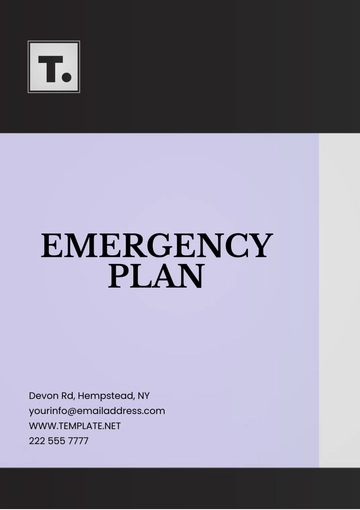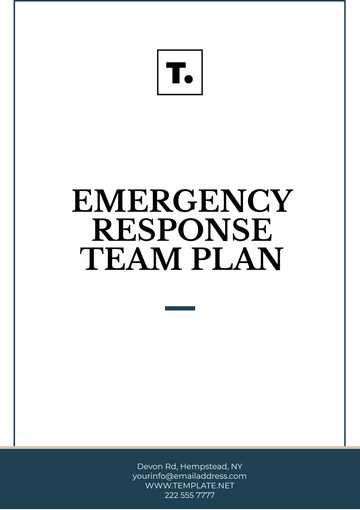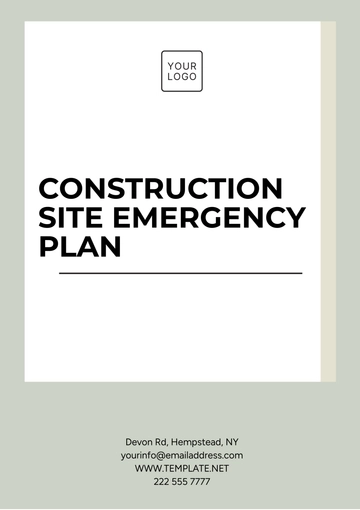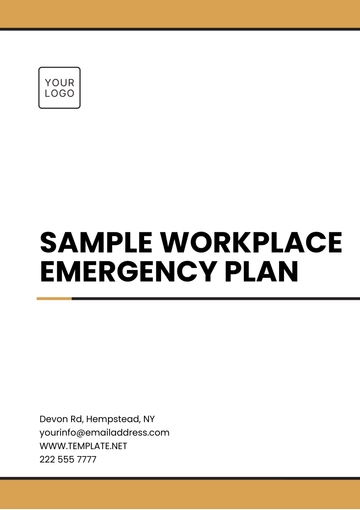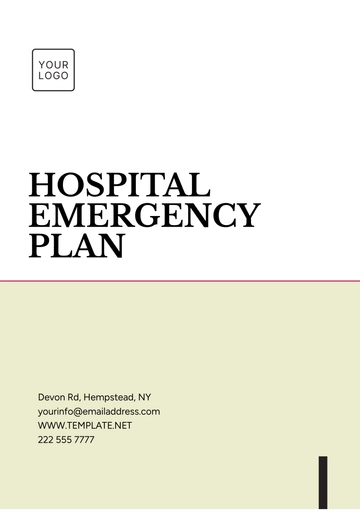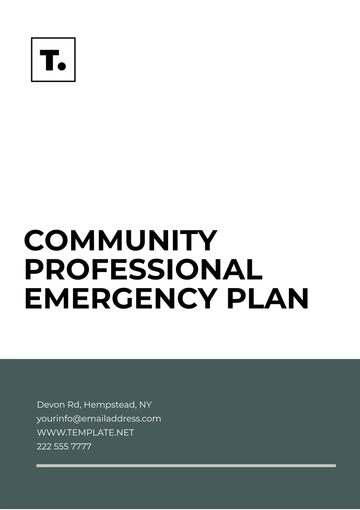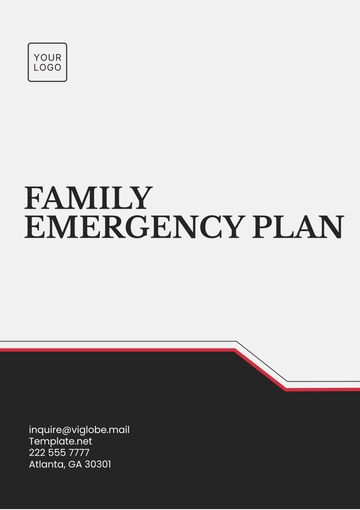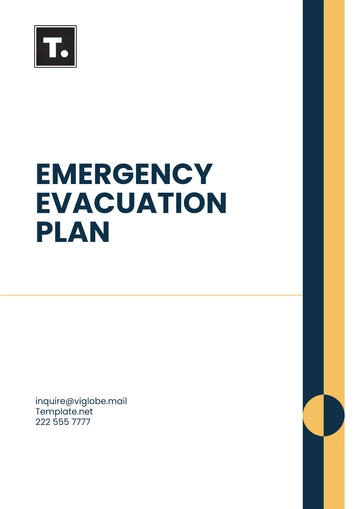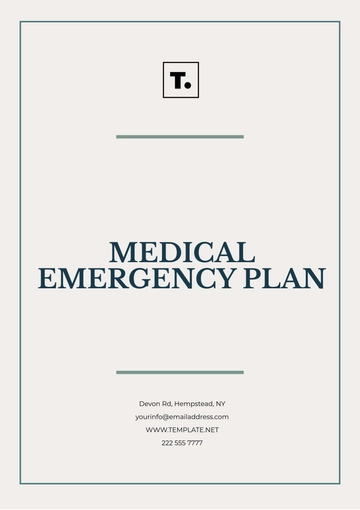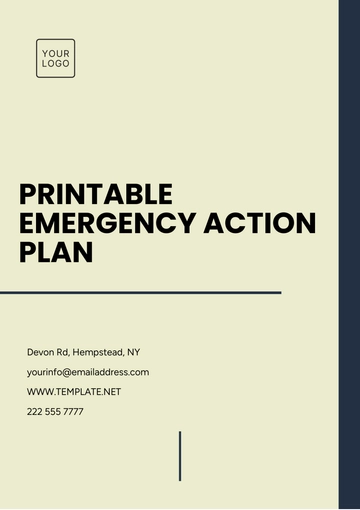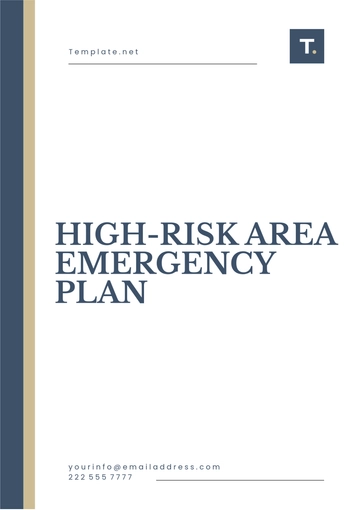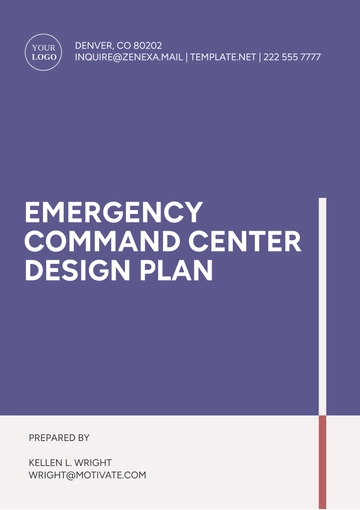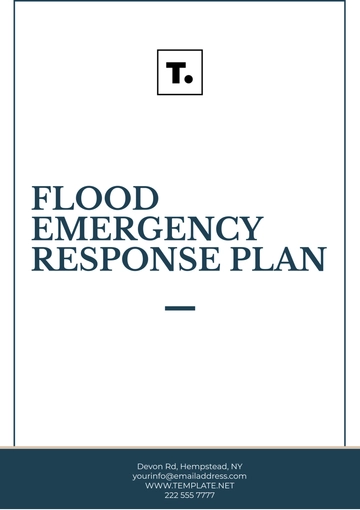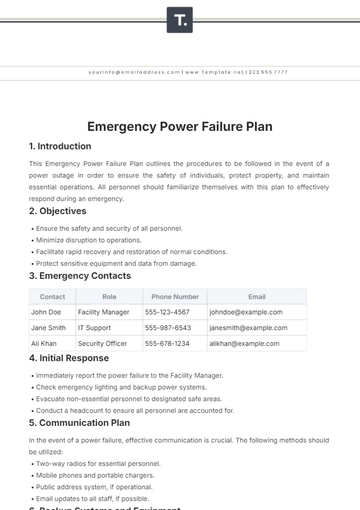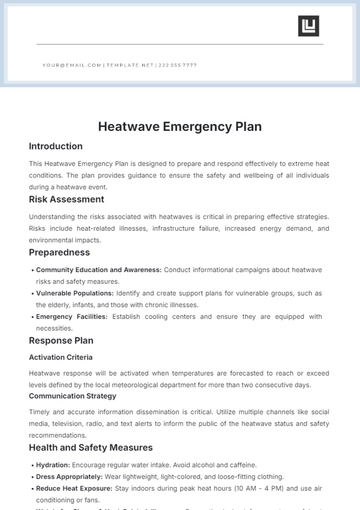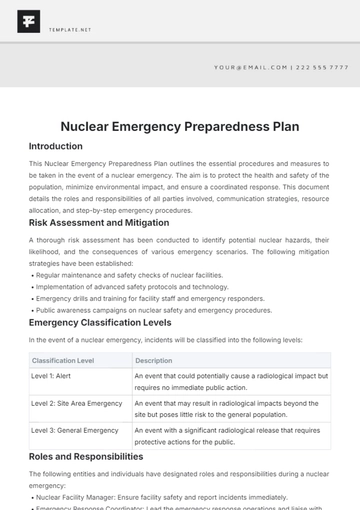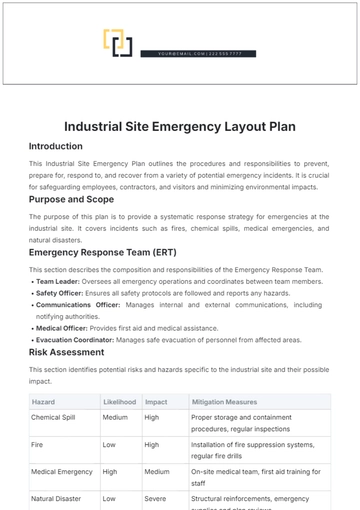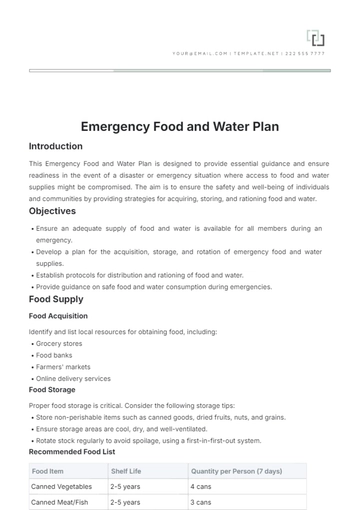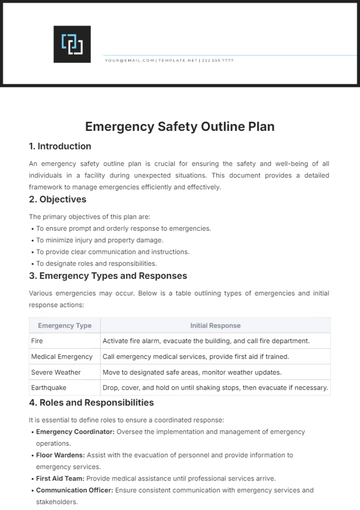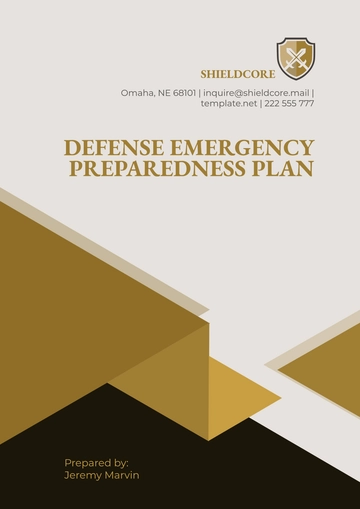Free Day Care Evacuation Plan
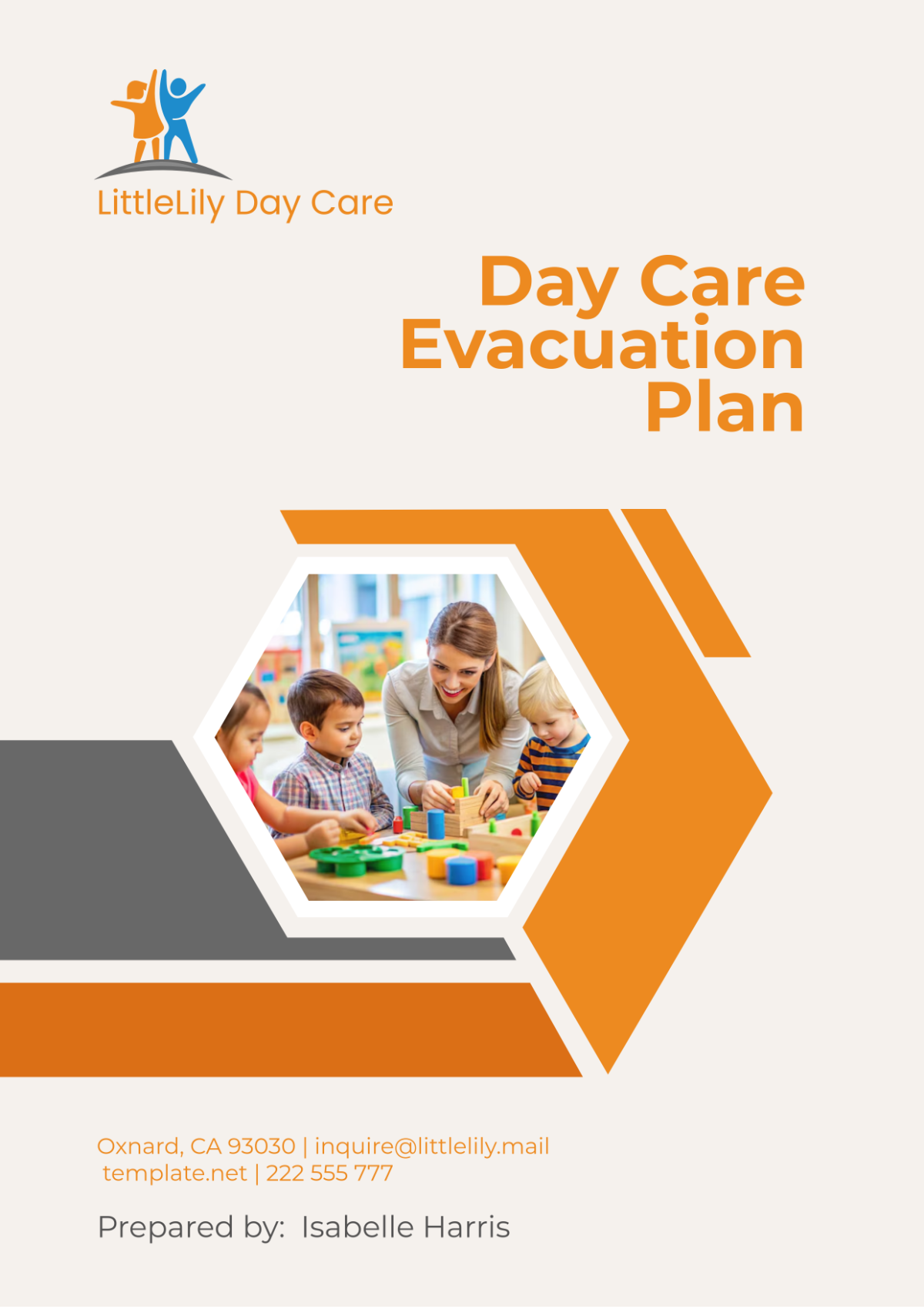
1. Introduction
The Day Care Evacuation Plan for [Your Company Name] is a meticulously crafted document designed to safeguard the well-being of all children, staff, and visitors during emergencies that require a prompt and organized evacuation of the facility. Emergencies can arise unexpectedly, necessitating immediate action to ensure safety. This plan outlines clear procedures that all individuals present at the daycare facility must follow to navigate through such challenging situations effectively.
As we move further into the year [2050] and beyond, it is crucial that our emergency protocols evolve to incorporate the latest advancements in technology, updated regulatory requirements, and best practices within the child care sector. The safety and health of our children are paramount, and this evacuation plan serves as a foundational tool to ensure that every child and staff member is prepared to act swiftly and safely in the face of danger.
2. Purpose of the Plan
The primary purpose of the Day Care Evacuation Plan is to provide structured, actionable steps that will be taken in response to various emergencies to protect the health and safety of children, staff, and visitors. The overarching goals of this plan include:
Awareness: Ensuring that all children, staff, and visitors are familiar with the evacuation procedures and know how to respond effectively during emergencies.
Clarity: Reducing confusion and panic during emergencies by establishing a well-documented plan that everyone can reference.
Coordination: Establishing clear roles and responsibilities for staff members during an evacuation, ensuring a coordinated response to emergencies.
Communication: Providing guidance on effective communication strategies to ensure that everyone is informed before, during, and after an emergency event.
By implementing this comprehensive plan, [Your Company Name] aims to cultivate a safe and supportive environment for children while fostering confidence among parents and staff regarding our emergency preparedness measures.
3. Scope of the Plan
This evacuation plan is applicable to all areas of the Day Care facility, encompassing classrooms, playgrounds, administrative offices, and any locations where children might be present or engaged in activities. The plan covers a broad spectrum of personnel, including:
All Staff Members: This encompasses full-time employees, part-time workers, volunteers, and any substitute personnel.
All Children Enrolled: This includes infants, toddlers, and preschoolers, ensuring that our procedures address the unique needs of each age group.
Visitors and Parents: Any parents, guardians, or visitors present during an emergency will be included in the plan's scope.
The plan is designed to address various potential emergencies, ensuring that [Your Company Name] is prepared for a wide range of situations, including but not limited to:
Emergency Type | Description |
|---|---|
Fire | Uncontrolled flames that may spread rapidly and pose a significant risk to health and safety, necessitating immediate evacuation. |
Natural Disaster | Events such as earthquakes, hurricanes, tornadoes, or floods that may disrupt normal operations and pose a threat to safety. |
Chemical Spill | Incidents involving hazardous materials that could adversely affect air quality or require immediate evacuation to a safe distance. |
Active Shooter | Situations where an individual actively threatens harm, requiring immediate lockdown or evacuation procedures to protect children and staff. |
Bomb Threat | Reports of a potential explosive device, necessitating evacuation to ensure the safety of all individuals in the facility. |
By considering a wide array of scenarios and potential emergencies, [Your Company Name] ensures a comprehensive approach to safety that is adaptable and effective.
4. Roles and Responsibilities
A well-coordinated evacuation effort relies heavily on the clear delineation of roles and responsibilities among all staff members. This section outlines the key responsibilities assigned to management, staff, and emergency responders to ensure effective implementation of the evacuation plan.
4.1 Management
The management team at [Your Company Name] is responsible for overseeing the implementation of the evacuation plan and ensuring its effectiveness. Their specific responsibilities include:
Training Oversight: Ensuring all staff members receive adequate training on the evacuation procedures and are aware of their specific roles during an emergency. This includes scheduling training sessions and providing necessary resources.
Plan Updates: Conducting regular reviews and updates of the evacuation plan to incorporate feedback, lessons learned from drills, and any changes in legislation or best practices in emergency preparedness.
Emergency Supplies Management: Overseeing the maintenance and replenishment of emergency supplies, including first-aid kits, flashlights, emergency food and water supplies, and communication devices. This ensures that all materials are up to date and accessible during an emergency.
Coordination with External Emergency Responders: Serving as the primary point of contact for local fire, police, and emergency medical services to facilitate effective communication and coordination during emergencies.
4.2 Staff
All staff members play a crucial role in executing the evacuation plan effectively. Their responsibilities include:
Familiarization with Procedures: Taking the time to understand and familiarize themselves with the evacuation routes, assembly points, and their specific duties during an emergency.
Calm and Orderly Evacuation: Leading children to safety in an orderly and calm manner, ensuring that children are encouraged to walk rather than run, minimizing panic, and maintaining control throughout the process.
Headcounts: Conducting headcounts at designated assembly points to ensure that all children are accounted for and that no one is left behind. This process should be thorough and methodical, emphasizing the importance of accuracy.
Immediate Reporting: Communicating any issues, concerns, or missing individuals to management immediately after reaching the assembly point to facilitate prompt action.
4.3 Emergency Responders
Emergency responders, including local fire, police, and emergency medical services, play an essential role in supporting the evacuation process and ensuring the safety of all individuals involved. Their responsibilities include:
Situation Assessment: Providing assistance and guidance during an emergency by assessing the situation upon arrival and determining the best course of action to ensure safety.
Coordination with Staff: Working closely with staff to facilitate the evacuation process, including providing information on how to manage specific emergency situations effectively.
Assistance with Special Needs: Assisting in evacuating any individuals who may be trapped, injured, or in need of special assistance, ensuring that all children and staff are accounted for and safe.
5. Evacuation Procedures
5.1 Types of Emergencies
Understanding the various types of emergencies is crucial for effective evacuation. Each type of emergency may require different responses, as detailed below:
Emergency Type | Description | Required Response |
|---|---|---|
Fire | Uncontrolled flames that may spread rapidly and pose a significant risk to health and safety, necessitating immediate evacuation. | Activate alarm, follow evacuation routes, gather at assembly point. |
Natural Disaster | Events such as earthquakes, hurricanes, tornadoes, or floods that may disrupt normal operations and pose a threat to safety. | Follow safety protocols specific to the disaster type; evacuate if necessary. |
Chemical Spill | Incidents involving hazardous materials that could adversely affect air quality or require immediate evacuation to a safe distance. | Evacuate the area, notify authorities, and follow chemical spill procedures. |
Active Shooter | Situations where an individual actively threatens harm, requiring immediate lockdown or evacuation procedures to protect children and staff. | Lockdown or evacuate based on situational assessment; prioritize safety. |
Bomb Threat | Reports of a potential explosive device, necessitating evacuation to ensure the safety of all individuals in the facility. | Evacuate immediately, follow police instructions, and maintain distance from the building. |
Each type of emergency requires specific training and preparation to ensure that all staff members are equipped to handle the situation effectively.
5.2 Evacuation Routes
Establishing designated evacuation routes is vital for ensuring all staff and children can exit the facility quickly and safely. These routes should be clearly marked and well-known to everyone.
Main Exit Route: The primary route should be the most direct and safest way out of the facility. It must be clearly marked with visible signage and kept free of obstructions. Staff should regularly check for any barriers that may impede access.
Secondary Exit Route: A secondary route must be identified and communicated to staff and children for situations where the main route may be compromised due to fire, debris, or other obstacles.
Special Needs Route: For children with mobility challenges, alternative routes and procedures should be identified and practiced. This may involve using accessible entrances or designated paths that are easier to navigate.
A visual map of evacuation routes will be displayed prominently throughout the facility in classrooms, hallways, and common areas to assist with orientation. The map will be updated as necessary to reflect any changes in the building layout or procedures.
5.3 Assembly Points
Once outside, it is crucial that all staff and children gather at designated assembly points to ensure accountability and safety. The assembly points should be located at a safe distance from the building and away from potential hazards.
Primary Assembly Point: The main assembly area should be easily accessible and familiar to everyone. It should be located at least [100] feet away from the building to ensure safety.
Secondary Assembly Point: A backup assembly area should be designated in case the primary point is compromised. This location should also be familiar to staff and children, ensuring everyone knows where to go in case of an emergency.
Accountability Check: Staff members will conduct a headcount at the assembly points to ensure all children are accounted for. This process should be thorough and methodical, utilizing attendance lists and familiarity with the children's names.
Assembly Point | Location Description | Capacity | Notes |
|---|---|---|---|
Primary Point | Grass area by playground | [50] | Clear of obstacles, well lit |
Secondary Point | Parking lot entrance | [75] | Accessible for emergency vehicles |
6. Emergency Communication
Effective communication during emergencies is crucial for ensuring the safety and security of all individuals involved. [Your Company Name] has established specific communication protocols to be followed during emergencies.
6.1 Internal Communication
Clear internal communication is essential to ensure that all staff are informed and can respond quickly and effectively during an emergency. The following measures will be implemented:
Emergency Alarm System: A loud, clear alarm system will be installed and tested regularly. This alarm will signal the need to evacuate and inform all staff and children that immediate action is required.
Communication Devices: Staff will be equipped with two-way radios or other reliable communication devices to maintain contact during an evacuation. This will facilitate real-time updates and coordination among staff members.
Designated Communication Officer: A designated staff member will be responsible for managing internal communication during an emergency, ensuring that everyone is informed about the situation and evacuation procedures.
6.2 External Communication
Effective external communication is critical for keeping parents, emergency responders, and the community informed during emergencies. The following strategies will be employed:
Parent Notification System: An automated notification system will be implemented to inform parents of emergencies, evacuation procedures, and updates regarding their children. Parents will be encouraged to provide multiple contact numbers to ensure effective communication.
Social Media and Website Updates: [Your Company Name] will utilize social media platforms and the official website to provide real-time updates to parents and the community regarding the situation, including information about the safety of children and staff.
Liaison with Emergency Responders: Management will serve as the primary point of contact for emergency responders to ensure a coordinated response and share essential information about the situation at hand.
7. Training and Drills
Regular training and drills are vital for ensuring that all staff members are well-prepared to implement the evacuation plan effectively. This section outlines the training and drill requirements for [Your Company Name].
7.1 Regular Drills
Evacuation drills will be conducted on a routine basis to familiarize staff and children with the procedures outlined in the evacuation plan. The following guidelines will be established for drills:
Frequency: Evacuation drills will occur at least twice a year, with additional drills scheduled as needed to address any changes in the facility or procedures.
Realistic Scenarios: Each drill will simulate various emergency scenarios to provide staff and children with practical experience in responding to different situations. This will help build confidence and familiarity with the procedures.
Evaluation and Feedback: After each drill, staff members will participate in a debriefing session to discuss the effectiveness of the drill, identify any challenges faced, and gather feedback to improve future drills.
7.2 Staff Training
All staff members will receive comprehensive training on the evacuation plan and their specific roles within it. Training will include the following components:
Initial Training: New staff members will receive training during their onboarding process, ensuring they understand the evacuation plan and their responsibilities.
Ongoing Training: Existing staff members will participate in ongoing training sessions at least [once a year] to stay updated on any changes to the plan and reinforce their knowledge and skills.
Special Needs Training: Staff members will receive additional training on how to assist children with special needs during an evacuation, ensuring that every child is safe and supported.
8. Special Considerations
8.1 Children with Special Needs
[Your Company Name] is committed to ensuring the safety of all children, including those with special needs. Specific considerations will be made in the evacuation plan to accommodate these individuals:
Individual Emergency Plans: For children with unique medical, mobility, or behavioral needs, individualized emergency plans will be developed and communicated to all staff members. These plans will outline specific procedures for safely evacuating the child in the event of an emergency.
Staff Training: Staff will receive specialized training on how to assist children with special needs during evacuations, including techniques for calming children and providing necessary medical assistance.
Equipment Accessibility: Necessary equipment, such as wheelchairs, mobility aids, or medical supplies, will be kept readily accessible to ensure that children can be evacuated safely and efficiently.
8.2 Visitors and Parents
Visitors and parents present at [Your Company Name] during an emergency will be included in the evacuation plan. Specific protocols will be established to ensure their safety:
Visitor Check-In Procedures: All visitors will be required to check in upon arrival, providing their contact information and any relevant medical information. This will facilitate accurate accounting during evacuations.
Communication During Emergencies: Parents will be informed of evacuation procedures and the designated assembly points, ensuring they know how to locate their children in an emergency.
Support for Parents: Staff will be trained to provide assistance to parents during an evacuation, helping them understand the process and ensuring they remain calm and informed.
9. Plan Maintenance and Review
To ensure the ongoing effectiveness of the Day Care Evacuation Plan, regular maintenance and review are necessary. The following actions will be taken:
Annual Review: The plan will be reviewed and updated annually to reflect any changes in procedures, legislation, or best practices. This process will involve collaboration among staff members, management, and emergency responders to ensure comprehensive input.
Feedback Mechanism: Staff and parents will be encouraged to provide feedback on the evacuation process, which will be considered during reviews. Surveys and suggestion boxes will be utilized to gather insights and improve the plan.
Record Keeping: All training sessions, drills, and reviews will be documented to maintain a historical record of compliance and improvements. This documentation will be accessible to staff and management to track progress and identify areas for further development.
10. Conclusion
The Day Care Evacuation Plan for [Your Company Name] is an essential framework for ensuring the safety and well-being of all children, staff, and visitors during emergencies. By clearly defining roles, establishing evacuation procedures, and maintaining open lines of communication, we can create a secure environment that promotes safety and confidence.
In the year [2050] and beyond, [Your Company Name] is committed to continuously improving our emergency preparedness and response strategies to adapt to the ever-changing landscape of potential risks. The health and safety of our children remain our top priority, and this evacuation plan is a critical component of our overall safety strategy.
Through regular training, effective communication, and a commitment to excellence, we can ensure that in any situation requiring evacuation, our children and staff will respond effectively, calmly, and safely.
- 100% Customizable, free editor
- Access 1 Million+ Templates, photo’s & graphics
- Download or share as a template
- Click and replace photos, graphics, text, backgrounds
- Resize, crop, AI write & more
- Access advanced editor
Prioritize safety with the Day Care Evacuation Plan Template from Template.net. This editable and customizable template provides guidelines for safe, organized evacuations in case of emergency. Customize it in our Ai Editor Tool to ensure thorough and accessible safety planning.
You may also like
- Finance Plan
- Construction Plan
- Sales Plan
- Development Plan
- Career Plan
- Budget Plan
- HR Plan
- Education Plan
- Transition Plan
- Work Plan
- Training Plan
- Communication Plan
- Operation Plan
- Health And Safety Plan
- Strategy Plan
- Professional Development Plan
- Advertising Plan
- Risk Management Plan
- Restaurant Plan
- School Plan
- Nursing Home Patient Care Plan
- Nursing Care Plan
- Plan Event
- Startup Plan
- Social Media Plan
- Staffing Plan
- Annual Plan
- Content Plan
- Payment Plan
- Implementation Plan
- Hotel Plan
- Workout Plan
- Accounting Plan
- Campaign Plan
- Essay Plan
- 30 60 90 Day Plan
- Research Plan
- Recruitment Plan
- 90 Day Plan
- Quarterly Plan
- Emergency Plan
- 5 Year Plan
- Gym Plan
- Personal Plan
- IT and Software Plan
- Treatment Plan
- Real Estate Plan
- Law Firm Plan
- Healthcare Plan
- Improvement Plan
- Media Plan
- 5 Year Business Plan
- Learning Plan
- Marketing Campaign Plan
- Travel Agency Plan
- Cleaning Services Plan
- Interior Design Plan
- Performance Plan
- PR Plan
- Birth Plan
- Life Plan
- SEO Plan
- Disaster Recovery Plan
- Continuity Plan
- Launch Plan
- Legal Plan
- Behavior Plan
- Performance Improvement Plan
- Salon Plan
- Security Plan
- Security Management Plan
- Employee Development Plan
- Quality Plan
- Service Improvement Plan
- Growth Plan
- Incident Response Plan
- Basketball Plan
- Emergency Action Plan
- Product Launch Plan
- Spa Plan
- Employee Training Plan
- Data Analysis Plan
- Employee Action Plan
- Territory Plan
- Audit Plan
- Classroom Plan
- Activity Plan
- Parenting Plan
- Care Plan
- Project Execution Plan
- Exercise Plan
- Internship Plan
- Software Development Plan
- Continuous Improvement Plan
- Leave Plan
- 90 Day Sales Plan
- Advertising Agency Plan
- Employee Transition Plan
- Smart Action Plan
- Workplace Safety Plan
- Behavior Change Plan
- Contingency Plan
- Continuity of Operations Plan
- Health Plan
- Quality Control Plan
- Self Plan
- Sports Development Plan
- Change Management Plan
- Ecommerce Plan
- Personal Financial Plan
- Process Improvement Plan
- 30-60-90 Day Sales Plan
- Crisis Management Plan
- Engagement Plan
- Execution Plan
- Pandemic Plan
- Quality Assurance Plan
- Service Continuity Plan
- Agile Project Plan
- Fundraising Plan
- Job Transition Plan
- Asset Maintenance Plan
- Maintenance Plan
- Software Test Plan
- Staff Training and Development Plan
- 3 Year Plan
- Brand Activation Plan
- Release Plan
- Resource Plan
- Risk Mitigation Plan
- Teacher Plan
- 30 60 90 Day Plan for New Manager
- Food Safety Plan
- Food Truck Plan
- Hiring Plan
- Quality Management Plan
- Wellness Plan
- Behavior Intervention Plan
- Bonus Plan
- Investment Plan
- Maternity Leave Plan
- Pandemic Response Plan
- Succession Planning
- Coaching Plan
- Configuration Management Plan
- Remote Work Plan
- Self Care Plan
- Teaching Plan
- 100-Day Plan
- HACCP Plan
- Student Plan
- Sustainability Plan
- 30 60 90 Day Plan for Interview
- Access Plan
- Site Specific Safety Plan
